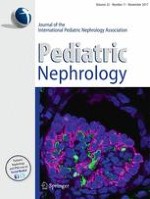Erschienen in:

28.06.2017 | Original Article
Nationwide conversion to generic tacrolimus in pediatric kidney transplant recipients
verfasst von:
Derisha Naicker, Peter W. Reed, Jane Ronaldson, Tonya Kara, William Wong, Chanel Prestidge
Erschienen in:
Pediatric Nephrology
|
Ausgabe 11/2017
Einloggen, um Zugang zu erhalten
Abstract
Background
Bioequivalence between Tacrolimus Prograf® and generic tacrolimus formulations has been demonstrated in adult populations, however clinical experience and safety data regarding generic tacrolimus in pediatric transplant recipients is limited. This study aimed to evaluate conversion from Tacrolimus Prograf® to Sandoz® in pediatric renal transplant recipients nationwide. The primary outcome was a change in mean trough tacrolimus concentration. Additionally, changes in tacrolimus intra-patient coefficient of variation (CoV), allograft function, requirement for dose adjustments, and episodes of biopsy-proven rejection were evaluated.
Methods
Retrospective cohort study in 37 pediatric renal transplant recipients who switched to Tacrolimus Sandoz®. Each patient had three pre-conversion tacrolimus trough and creatinine concentrations within the 4 months prior and three post-conversion concentrations on day 3, 10, and the next subsequent level. Mean pre- and post-conversion tacrolimus trough concentrations and glomerular filtration rate (eGFR) were calculated. Tacrolimus concentration, CoV, and creatinine differences were compared by paired t test.
Results
Thirty-seven patients (41% females, age 3–18 years) were included. Average intra-patient difference in trough tacrolimus concentration was 0.05μg/l (95% CI –0.37 to 0.47). Average intra-patient difference in eGFR was −1.20 ml/min/1.732 (95% CI –3.53 to 1.13). Three patients had acute rejection during 12 months post-conversion compared to none during 12 months pre-conversion.
Conclusions
Pediatric renal transplant recipients can be converted from Tacrolimus Prograf® to Sandoz® with negligible change in trough concentration, dose adjustments, or immediate allograft function. Of concern was the number of acute rejection episodes, however non-adherence contributed to at least one episode and this difference was determined clinically and statistically not significant.